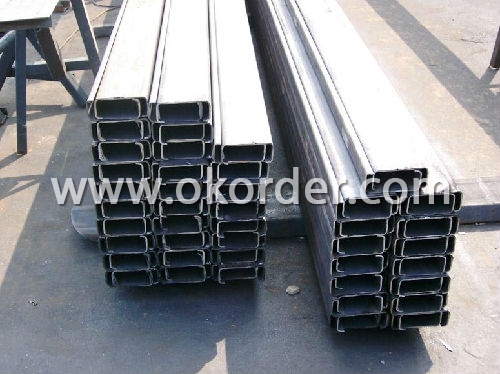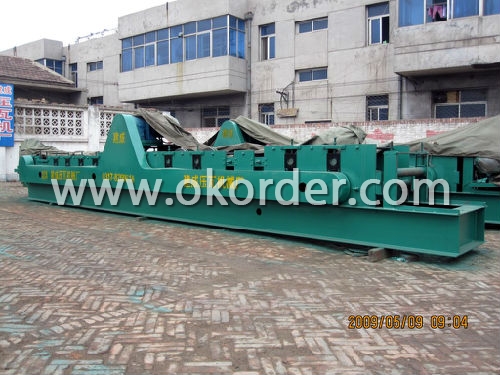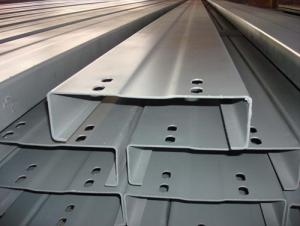High Quality And Low Price CR C Bar
- Loading Port:
- Tianjin Port,China
- Payment Terms:
- TT or LC
- Min Order Qty:
- 20Tons m.t.
- Supply Capability:
- 1000 tons per month m.t./month
OKorder Service Pledge
OKorder Financial Service
You Might Also Like
Specifications of High Quality And Low Price CR C Bar:
1.We supply high quality High Quality And Low Price CR C Bar at reasonable price, including Chinese standard, Japanese standard and so on.
Size | Weight(kg/m) | Size | Weight(kg/m) |
80×40×20×2.5 | 3.925 | 180×60×20×3 | 8.007 |
80×40×20×3 | 4.71 | 180×70×20×2.5 | 7.065 |
100×50×20×2.5 | 4.71 | 180×70×20×3 | 8.478 |
100×50×20×3 | 5.652 | 200×50×20×2.5 | 6.673 |
120×50×20×2.5 | 5.103 | 200×50×20×3 | 8.007 |
120×50×20×3 | 6.123 | 200×60×20×2.5 | 7.065 |
120×60×20×2.5 | 5.495 | 200×60×20×3 | 8.478 |
120×60×20×3 | 6.594 | 200×70×20×2.5 | 7.458 |
120×70×20×2.5 | 5.888 | 200×70×20×3 | 8.949 |
120×70×20×3 | 7.065 | 220×60×20×2.5 | 7.4567 |
140×50×20×2.5 | 5.495 | 220×60×20×3 | 8.949 |
140×50×20×3 | 6.594 | 220×70×20×2.5 | 7.85 |
160×50×20×2.5 | 5.888 | 220×70×20×3 | 9.42 |
160×50×20×3 | 7.065 | 250×75×20×2.5 | 8.634 |
160×60×20×2.5 | 6.28 | 250×75×20×3 | 10.362 |
160×60×20×3 | 7.536 | 280×80×20×2.5 | 9.42 |
160×70×20×2.5 | 6.673 | 280×80×20×3 | 11.304 |
160×70×20×3 | 8.007 | 300×80×20×2.5 | 9.813 |
180×50×20×2.5 | 6.28 | 300×80×20×3 | 11.775 |
180×50×20×3 | 7.536 | ||
180×60×20×2.5 | 6.673 |
Note: we are also competent to provide our customers other High Quality And Low Price CR C Bar based on other sizes according to customer’s requirements.
2. The detailed sections of High Quality And Low Price CR C Bar as per GB standard.Just as followings in the table-1:
Standard | GB/JIS/EN/ASTM/DIN |
Material Grade | Q235B,Q235,Q345,Q345B,SS400,S235JRG1,A36,ST37-2 |
Technique: | Cold Rolled |
Sizes as per chinese standard: |
80×40×20×2.5 - 180×60×20×2.5
|
Sizes as per Japanese standard: |
180×60×20×3 – 300×80×20×3 |
Length: | 6meter, 9meter, 12meter |
Table-1
3. The chemical composition of High Quality And Low Price CR C Bar according to Q235B is shown in Table-2.
Alloy No | Grade | Element(%) | ||||
C | Mn | S | P | Si | ||
Q235 | B | 0.12-0.20 | 0.3-0.7 | ≦0.045 | ≦0.045 | ≦0.3 |
Table-2
Note: we are able to present our customers relevant SGS test report for chemical composition of High Quality And Low Price CR C Bar.
4. The mechanical property of High Quality And Low Price CR C Bar according to Q235B is shown in Table-3-1 and Table-3-2
Alloy No | Grade | Yielding Strength Point(Mpa) | |||
Thickness(mm) | |||||
≦16 | >16-40 | >40-60 | >60-100 | ||
≧ | |||||
Q235 | B | 235 | 225 | 215 | 205 |
Table-3-1
Alloy No | Grade | Tensile Strength(Mpa) | Elongation After Fracture(%) | |||
Thickness(mm) | ||||||
≦16 | >16-40 | >40-60 | >60-100 | |||
≧ | ||||||
G235 | B | 375-500 | 26 | 25 | 24 | 23 |
Table-3-2
Note: we are able to present our customers relevant SGS test report for mechanical property of High Quality And Low Price CR C Bar as customer’s request.
Applications of High Quality And Low Price CR C Bar:
The High Quality And Low Price CR C Bar can be applied to construction of warehouses, workshops, sport stadiums and car parks etc.The hot rolled channel steel belongs to carbon structural steel which is applied to in the field of construction and machinery.In details, the hot rolled channel steel is usually used for arch-itechtural structure, and they could be welded in order to support or hang a vari-ety of facilities. They are also usually used in combination with I beam. Generally,the hot rolled channel steel we supply must possess perfect welding property, riveting property and mechanical property and so on.
Package & Delivery of High Quality And Low Price CR C Bar:
1.The hot rolled channel steel will be packed in bundle with steel wire at each end of every bundle and color marking in order to help the customer to recognize his goods more easily at sight.
2. And the hot rolled channel steel could be loaded into 20ft or 40ft container, or by bulk cargo.If the weight of each bundle reaches more than 3.5 mt, the loading by break bulk cargo should be choosed.When the weight of each bundle reaches less than 3mt, the loading by container should be choosed.
3.As for the transportaion from mill to loading port, the truck will be usually used. And the maximum quantity for each truck is 40mt.
4.All in all, we could do in accordance with customer's request.

Production Flow of High Quality And Low Price CR C Bar:
1.The steel billet shall be heated in the high temperature furnace.
2. The heated steel billet shall be rolled five to nine times with the aim of shaping the general figure of steel u channel.
3. The hot rolled channel steel should be put onto the cooling bed to make the temperature low.
4. The channel steel should be straighted on the straightener.
5. The straighted channel steel will be cut into meters by saw, as per customer's requirements.

- Q:What are the different surface finishes available for steel channels in architectural applications?
- In architectural applications, steel channels have multiple surface finish options available. These finishes are applied to improve the steel channels' appearance, durability, and resistance to corrosion. Some commonly used surface finishes for steel channels in architectural applications include the following: 1. Mill finish: This is the initial finish obtained after manufacturing the steel channel. It has a rough, untreated surface and may have visible imperfections. Mill finish is suitable for situations where the steel channel will be covered or painted. 2. Galvanized finish: The galvanizing process involves applying a protective zinc coating to the steel channel to prevent corrosion. This finish offers excellent corrosion resistance and is commonly used in outdoor applications or environments with high humidity or chemical exposure. 3. Powder coating: In this dry finishing process, a fine powder is electrostatically applied to the steel channel and then cured under heat. Powder coating provides a durable and smooth surface with a wide range of color options. It is often used for decorative purposes and to provide additional corrosion protection. 4. Brushed finish: The brushing process involves using a wire brush to create a fine texture on the surface of the steel channel. This finish gives the steel channel a brushed or satin appearance and is popular for architectural applications that require a more refined look. 5. Polished finish: Polishing includes mechanical or chemical treatments to achieve a smooth and reflective surface on the steel channel. This finish is commonly used for decorative purposes and can create a luxurious, high-end appearance. 6. Painted finish: Steel channels can also be painted with various coatings to enhance their aesthetic appeal and protect against corrosion. Painted finishes offer a wide range of color options and can be customized to match the design requirements of the architectural application. The choice of surface finish for steel channels in architectural applications depends on factors such as the desired appearance, level of corrosion resistance required, and specific environmental conditions the steel channels will face.
- Q:What material is the channel steel bought in the steel market?
- The mass fraction of Q195, Q215, Q235 are usually of low carbon steel, good welding performance, good plasticity and toughness, a certain strength, often rolled into a sheet, steel, welded steel pipe, used for bridges, buildings and general manufacturing rivet, screw and nut parts etc..
- Q:What is the load-bearing capacity of steel channels?
- The load-bearing capacity of steel channels can vary depending on various factors such as the size, shape, and grade of the steel channel. It is essential to refer to engineering specifications and consult structural engineers or relevant resources to determine the exact load-bearing capacity for a specific steel channel.
- Q:How long do steel channels typically last?
- Steel channels typically have a long lifespan and can last for several decades if properly maintained. However, the exact duration can vary depending on factors such as the quality of the steel, exposure to environmental conditions, and level of maintenance.
- Q:Are steel channels suitable for high-temperature applications?
- No, steel channels are not typically suitable for high-temperature applications as they can weaken and deform under prolonged exposure to high temperatures.
- Q:What are the different types of corrosion protection for steel channels?
- Steel channels have various corrosion protection methods available, depending on specific requirements and environmental conditions. Some common methods include: 1. Galvanization: A highly popular corrosion protection method for steel channels involves coating them with a layer of sacrificial zinc. This prevents corrosion by corroding the zinc layer instead of the steel. 2. Powder coating: Channels can be protected by applying a dry powder, which is then baked to create a protective layer. This not only offers excellent corrosion resistance but also enhances the channels' aesthetics. 3. Epoxy coatings: Aggressive environments often require the use of epoxy coatings. These create a durable barrier against moisture and chemicals, preventing corrosion of the steel channels. 4. Paint coatings: Cost-effective paint coatings involve applying multiple layers to form a barrier between the metal and corrosive elements in the environment. 5. Hot-dip galvanizing: Immersing steel channels in molten zinc provides a thicker and more durable layer of protection compared to regular galvanization. 6. Cathodic protection: This technique protects steel channels by making them the cathode in a corrosion cell. Channels are connected to a sacrificial anode, such as zinc or magnesium, which corrodes instead of the steel. 7. Stainless steel: Using stainless steel channels is an effective way to prevent corrosion. The high chromium content forms a passive oxide layer on the surface, protecting it from corrosion. To ensure the longevity and durability of steel channels, it is essential to select the appropriate corrosion protection method based on factors such as the environment, expected lifespan, and cost considerations.
- Q:Are steel channels suitable for use in corrosive environments?
- Depending on the steel type and specific environmental conditions, steel channels can be used in corrosive environments. For instance, stainless steel channels are highly resistant to corrosion due to chromium and other alloying elements. These channels are commonly used in industries like chemical processing, marine, and food processing, where exposure to corrosive materials or environments is frequent. However, not all steel channels are equally suited for corrosive environments. Carbon steel channels, for example, are more prone to corrosion and may need additional protective measures like coatings or regular maintenance to prevent rusting. In extremely corrosive environments, specialized alloys like duplex or super duplex stainless steel channels may be required for optimal corrosion resistance. Furthermore, factors such as temperature, humidity, and the concentration of corrosive agents play a significant role in determining the suitability of steel channels in corrosive environments. Seeking guidance from corrosion engineers or specialists can assist in selecting the appropriate steel type and protective measures to ensure the longevity and performance of steel channels in such environments.
- Q:Can steel channels be used for racking systems?
- Yes, steel channels can be used for racking systems. Steel channels provide a strong and durable solution for storing heavy loads. They are typically designed with a C-shape, allowing for easy installation and providing a sturdy support structure for the racking system. Steel channels can be used in various types of racking systems, such as pallet racks, cantilever racks, and mezzanine racks. They offer excellent load-bearing capabilities and can withstand the weight and pressure exerted by the stored items. Moreover, steel channels are resistant to corrosion, making them suitable for both indoor and outdoor racking systems. Overall, steel channels are a reliable and versatile choice for constructing efficient and safe racking systems.
- Q:What are the different types of bending for steel channels?
- There are several different types of bending methods that can be used for steel channels. These methods include cold bending, hot bending, and press brake bending. 1. Cold Bending: This method involves shaping the steel channel using force without heating it. It is a common method used for bending steel channels, as it is cost-effective and does not require specialized equipment. Cold bending can be done manually using tools such as hammers, pipe benders, or hydraulic benders. It is suitable for smaller and simpler bending projects. 2. Hot Bending: Hot bending involves heating the steel channel to a specific temperature before shaping it. This method is typically used for larger and more complex bending projects, as it allows for more precise and controlled bending. Hot bending is commonly done using induction heating or flame heating techniques. The heated steel channel is then bent using hydraulic or mechanical force. 3. Press Brake Bending: Press brake bending is a method that uses a machine called a press brake to bend steel channels. This method is highly accurate and suitable for large-scale production. The press brake machine consists of a punch and a die that are used to shape the steel channel. The steel channel is placed between the punch and the die, and the press brake applies force to bend it to the desired angle. Overall, the choice of bending method depends on factors such as the complexity of the bending project, the size of the steel channel, and the required precision. Each method has its own advantages and limitations, and it is important to choose the appropriate method based on these factors to ensure the desired outcome.
- Q:Can steel channels be used for facade cladding systems?
- Yes, steel channels can be used for facade cladding systems. Steel channels provide structural support and can be used as framing components for attaching cladding materials such as glass, metal panels, or composite materials. They offer durability, strength, and versatility, making them suitable for various facade designs and applications.
1. Manufacturer Overview |
|
|---|---|
| Location | Tianjin, China |
| Year Established | 2007 |
| Annual Output Value | Above US$ 15 Million |
| Main Markets | Southeast Asia; Africa |
| Company Certifications | |
2. Manufacturer Certificates |
|
|---|---|
| a) Certification Name | |
| Range | |
| Reference | |
| Validity Period | |
3. Manufacturer Capability |
|
|---|---|
| a)Trade Capacity | |
| Nearest Port | Tianjin |
| Export Percentage | 15%-20% |
| No.of Employees in Trade Department | 11-20 People |
| Language Spoken: | English; Chinese; |
| b)Factory Information | |
| Factory Size: | Above 6,500 square meters |
| No. of Production Lines | 1 |
| Contract Manufacturing | OEM service offered |
| Product Price Range | average |
Send your message to us
High Quality And Low Price CR C Bar
- Loading Port:
- Tianjin Port,China
- Payment Terms:
- TT or LC
- Min Order Qty:
- 20Tons m.t.
- Supply Capability:
- 1000 tons per month m.t./month
OKorder Service Pledge
OKorder Financial Service
Similar products
New products
Hot products
Related keywords





























